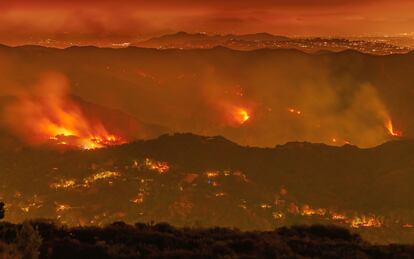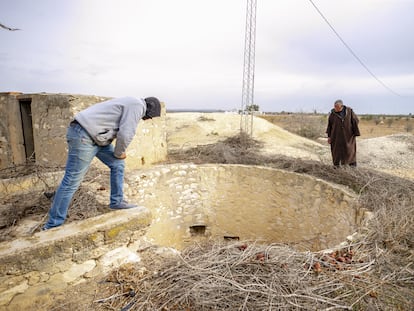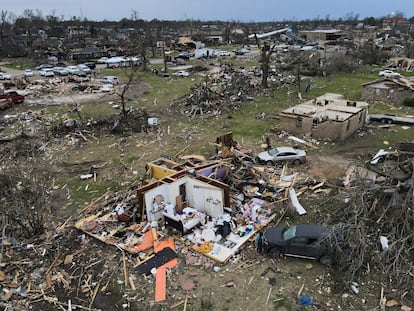Forest fires: An extra degree of temperature can increase the burned area by 222%
The evolution of fires in California shows how climate change is exacerbating the phenomenon around the world

Between 1971 and 1995, the area burned by fires in California averaged 361 km² (36,100 hectares) per year. Since 1996, the annual area burned has increased fivefold to 1,710 km² (171,000 hectares) per year. California has the strictest environmental legislation in the United States. The state is also a pioneer in forest management and fire control. Unlike Europe, there was no abandonment of the countryside to migrate to the cities because there was never much human occupation of the countryside in the first place. That left climatic factors. Analysis of 50 years of data confirms climate change’s role and shows that, if temperatures continue to increase in the future, the percentage of forest that burns will increase exponentially with every degree that the thermometer rises. California could serve as a model for what will happen in other regions that have a Mediterranean climate, as well as all areas that still have large forests, from Canada to Siberia.
Climate change is altering different meteorological parameters. Temperatures are rising, but irregularly and with extreme peaks that are advancing, lengthening and intensifying heat waves. Rainfall patterns are increasingly changing, with average precipitation decreasing in some areas and increasing in others. Almost everywhere on the planet, the rate of evapotranspiration or aridity (the moisture lost from the soil plus what plants sweat to cope with the heat) is increasing. All of this gives characteristic signs that a group of scientists have now measured for the northern region of California and the Sierra Nevada. The results of this study have just been published in the scientific journal PNAS.
The work attributes the increase in hectares burned between 1971 and 2021 to a series of factors. Some are climatic or meteorological, such as temperature and rainfall. Others are environmental or astronomical, such as emissions caused by volcanic eruptions and variations in radiation due to the solar cycle. The researchers also consider social factors, such as changes in land use and increasing urbanization. Finally, they include the accumulation of greenhouse gases such as CO₂, the fuel behind global warming and climate change, in their various equations.
“Human emissions are known, so it is enough to remove them from the simulation to know what the natural evolution would be like,” says Marco Turco, an Italian researcher at the University of Murcia (Spain) and a co-author of the paper published in PNAS. By subtracting and adding factors, they obtained scenarios that they compared with the real evolution since 1971. “We have seen that only simulations that include anthropogenic emissions explain the increase in burnt mass,” adds Turco, the director of ONFIRE, a Ministry of Science and Innovation project to study how climate change is affecting fires. The quality and age of the California data, which lends consistency to the results, is one of the reasons why it was a good place to start.
Turco’s study, which also involved researchers from several Californian and Spanish universities, found that until the 1990s, other factors, such as volcanic emissions, had an impact on fires, albeit a limited one. But almost 98% of the variation was due to climatic factors. Since 1971, the average temperature has increased 0.8º and the area burned each year has almost quintupled.
The research went further by looking at which climatic factor is the most determinant. While the potential decrease in precipitation or increase in average annual temperature could play a role, the authors of the paper noted that the key metric is the average maximum temperature recorded between the months of April and May. Turco explains that “precipitation, average temperature or high minimum temperatures “do not give rise to much evaporation of water inside the fuel” relative to the humidity in the wood, which is key to the evolution of fires. The Italian scientist clarifies that this is true for the forests of northern California and Sierra Nevada. In California, “we have seen that the fire-climate relationship is exponential; simply with a one-degree increase in the maximum monthly temperature there is a 222% increase in the area burned,” he adds.
In a second part of the work, they used a model validated by data from the past to project it into the future. Their results indicate that, if emissions continue and temperatures continue to rise, the area burned will continue to increase. “The more optimistic model gives a 40% increase in the area burned in relation to the present climate. With two degrees, this increase would be 60%, and if we go to three degrees, it would be a 97% increase,” Turco fears.
“Many of the elements that favor wildfires in forested parts of California are applicable to other countries with Mediterranean climates.”John Abatzogloub, director of the climatology lab at the University of California, Merced
John Abatzogloub, the director of the climatology lab at the University of California, Merced, and a co-author of the paper, observes that “many of the same elements that favor wildfires in forested parts of California are applicable to other countries with Mediterranean climates. This would…align with other work that suggests that climate change facilitates more fires in fuel-rich environments in these climates.” However, Abatzogloub adds, “I don’t think the numerical results are directly applicable, as these regions have different vegetation compositions, disturbance history, and land-use changes.”
Turco previously investigated the relationship between climate change and fires in the Mediterranean basin. He says that “there are similarities and differences [with the case of California].” In general, he continues, the relationship between climate and fires in the Mediterranean is very simple: the more drought, the bigger the fires. “But you really have to dig deeper,” he says. In addition to greater fuel dryness, you have to consider how much wood is actually available. “[In] the more productive areas where temperature and precipitation are more conducive to having forests, fires respond more to drought,” the scientist explains. He gives the example of areas that are more vulnerable to fires, like his homeland in northern Italy, than more arid areas, like Murcia where he works. In fact, he notes that “fires are decreasing in the arid areas of the Mediterranean.”
According to Emilio Chuvieco, a researcher at the University of Alcalá (Spain) who was not involved in this study, “the relationship between climate change and fires will be clearer where there is more fuel available, as in Canada or Siberia.” The latest data show that by June of this year as much Canadian forest had burned as in all of last year. But Chuvieco adds that in areas with higher temperatures but less water, “if there is no plant productivity, there will be fewer fires.” In general, he concludes that “hazard rates tend to increase around the world, but it depends on what is available to burn.”
Sign up for our weekly newsletter to get more English-language news coverage from EL PAÍS USA Edition
Tu suscripción se está usando en otro dispositivo
¿Quieres añadir otro usuario a tu suscripción?
Si continúas leyendo en este dispositivo, no se podrá leer en el otro.
FlechaTu suscripción se está usando en otro dispositivo y solo puedes acceder a EL PAÍS desde un dispositivo a la vez.
Si quieres compartir tu cuenta, cambia tu suscripción a la modalidad Premium, así podrás añadir otro usuario. Cada uno accederá con su propia cuenta de email, lo que os permitirá personalizar vuestra experiencia en EL PAÍS.
¿Tienes una suscripción de empresa? Accede aquí para contratar más cuentas.
En el caso de no saber quién está usando tu cuenta, te recomendamos cambiar tu contraseña aquí.
Si decides continuar compartiendo tu cuenta, este mensaje se mostrará en tu dispositivo y en el de la otra persona que está usando tu cuenta de forma indefinida, afectando a tu experiencia de lectura. Puedes consultar aquí los términos y condiciones de la suscripción digital.
More information
Archived In
Últimas noticias
The complicated life of Francesca Albanese: A rising figure in Italy but barred from every bank by Trump’s sanctions
Half of Scotland is in the hands of 420 property owners
Reinhard Genzel, Nobel laureate in physics: ‘One-minute videos will never give you the truth’
Pinochet’s victims grapple with José Antonio Kast’s rise in Chile
Most viewed
- Pablo Escobar’s hippos: A serious environmental problem, 40 years on
- Why we lost the habit of sleeping in two segments and how that changed our sense of time
- Charles Dubouloz, mountaineering star, retires at 36 with a farewell tour inspired by Walter Bonatti
- Trump’s obsession with putting his name on everything is unprecedented in the United States
- The Florida Keys tourist paradise is besieged by immigration agents: ‘We’ve never seen anything like this’











































